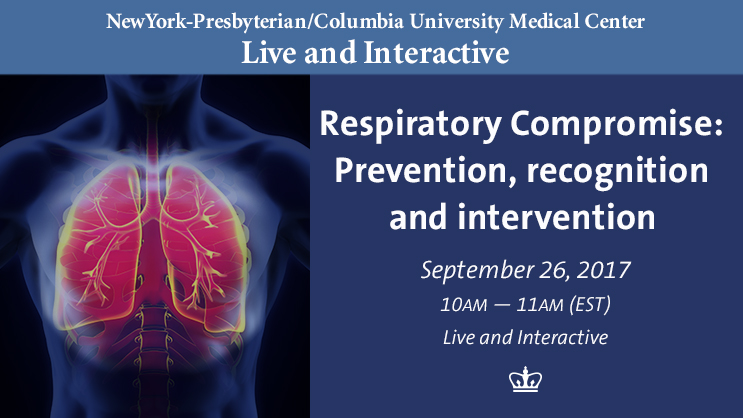
Click Here to Watch the Webinar »
Panelists
Paul Boerem, ACNP, RT, Critical Care Nurse Practitioner and Certified Respiratory Therapist
Department of Medicine, Pulmonary, Allergy and Critical Care
Monica P. Goldklang, MD, Assistant Professor of Medicine (in Anesthesiology)
Department of Anesthesiology, Critical Care Medicine
Steven E. Miller, MD, Assistant Professor of Anesthesiology (Moderator)
Department of Anesthesiology, Critical Care Medicine
Amanda J. Powers, MD, Assistant Professor of Surgery (in Anesthesiology)
Department of Surgery, Acute Care
Program Description
"Respiratory Compromise: Prevention, Recognition and Intervention" is a non-CME webinar discussion, which will focus on education leading to improved patient care and better outcomes for those with signs and symptoms of respiratory distress due to multiple causes in a variety of settings. Respiratory compromise—which includes respiratory insufficiency, arrest and failure—is a critical perioperative complication associated with increased costs and poor outcomes.
Target Audience
This activity is designed for general practitioners, emergency department physicians, and nurses, surgeons, first responders and operating room clinical staff.
Educational Needs Assessment
- Current monitoring strategies for the early identification of postoperative respiratory compromise may be inadequate.
- A comprehensive and continuous patient monitoring strategy encompassing respiratory rate, pulse oximetry and capnography has the potential to reduce the incidence and severity of postoperative respiratory compromise, and improve patient outcomes and reduce the cost of care.
- Respiratory insufficiency, arrest and failure (RIAF) is one of the five conditions resulting in the most rapidly increasing hospital costs for Medicare-covered stays in the U.S.
- Inpatients with RIAF originating on the general care floor had higher mortality rates, longer LOS and ICU stays than non-RIAF patients
- Delayed interventions occur in 50% of patients with respiratory distress.
- Respiratory abnormalities are the most common abnormalities prior to ICU admission.
- Bradypnea on the general care floor is independently associated with a high risk for subsequent death.
- Continuous monitoring of respiratory function provides notification to the medical professional of conditions that may, if unaddressed, lead to adverse events.
- Patient-controlled analgesia is a potential risk for respiratory compromise.
- Continuous monitoring with pulse oximetry provides early detection of physiological decline, which has been shown to reduce rescue events and ICU transfers.
Learning Objectives
- Recognize signs and symptoms of RIAF (RIAF encompasses respiratory compromise)
- Understand underlying conditions that contribute to RIAF
- Identify high-risk patients for developing RIAF
- Understand benefits of continuous respiratory function monitoring
- Mitigate respiratory deterioration
